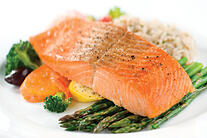 The proliferation of mercury in fish is a well-documented environmental problem. Mercury accumulates in fish tissue from natural and anthropogenic source in bodies of water where the fish live. The microorganisms at the base of the aquatic food change convert the elemental mercury into organic methylmercury, which binds tightly to the proteins in fish tissue. As bigger fish eat the smaller fish, the levels of mercury increase as much as one million times in comparison to the water. Humans then consume the contaminated fish, and can suffer from a variety of challenges, including damage to their cardiovascular, immune, respiratory, gastrointestinal and reproductive systems. Studies show that mercury poisoning is especially damaging to nervous system development in children.
The proliferation of mercury in fish is a well-documented environmental problem. Mercury accumulates in fish tissue from natural and anthropogenic source in bodies of water where the fish live. The microorganisms at the base of the aquatic food change convert the elemental mercury into organic methylmercury, which binds tightly to the proteins in fish tissue. As bigger fish eat the smaller fish, the levels of mercury increase as much as one million times in comparison to the water. Humans then consume the contaminated fish, and can suffer from a variety of challenges, including damage to their cardiovascular, immune, respiratory, gastrointestinal and reproductive systems. Studies show that mercury poisoning is especially damaging to nervous system development in children.
Recently, Teledyne Leeman Labs completed an analysis of mercury levels in tuna using the QuickTrace M-7600, a standalone mercury analyzer that uses CVAA spectrometry to produce qualitative data. Two samples were digested from Certified Reference Material (CRM) 463, purchased from the European Commission Joint Research Centre Environment Institute. The materials, collected from the Adriatic Sea, were produced from tuna that were rejected from normal trade because their mercury content exceeded 0.8 Mg/g.
The QuickTrace was paired with an autosampler for completely automated sample batch analysis. The 12-roller, four-channel peristaltic pump ensures consistent sample delivery to the analyzer providing consistent online sample/reagent mixing and mercury reduction in the analyzer’s closed-system architecture. The elemental sample flows over the post of the non-foaming Gas Liquid Separator (GLS) as it is continuously purged with argon or nitrogen. The elemental mercury vapor evolved from the liquid sample then passes through a Perma Pure® drying cartridge and finally to the sample cell where its absorbance is measured at a wavelength of 253.7 nm.
The tuna samples, which weighed 302 kg and 322 kg, were sliced frozen, minced and stored frozen in high-density polyethylene containers. The materials were freeze-dried until reaching the optimal moisture mass fraction below 2.5 percent. The samples were then frozen and sent to the Joint Research Centre of Ispra where they were grounded and sieved using a vibrating stainless steel sieve. The materials were stored in polyethylene boxes in an argon atmosphere and then homogenized in a mixing drum for 16 days. A total of 1000 bottles containing ca. 15 grams of material was produced for each candidate reference material.
Additional details on the treatment of the sample materials, the operating conditions instrument calibration standardization and procedures are available in Application Note – AN1607, Mercury Determination in Tuna.
Using the QuickTrace M-7600 for measuring mercury at μg/L levels was effective and produced reliable quantitative data. An analytical result of 2.75 mg/kg ± 0.18 dry mass basis was obtained. Uncertainty values correspond to a level of confidence at 95% and were calculated for the seven replicates of the CRM analyzed. CRM 463 has a certified concentration of 2.85 mg/kg with an uncertainty of ±0.16 mg/kg.
The instrument was successful at analyzing and determining the total elemental mercury concentration in the tuna (CRM 463).

Application Note – AN1607 provides additional details on the analysis and results, including tables and charts about results with uncertainties and representative peak.
